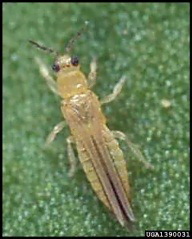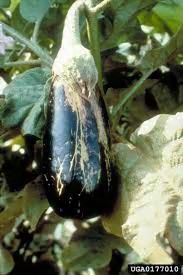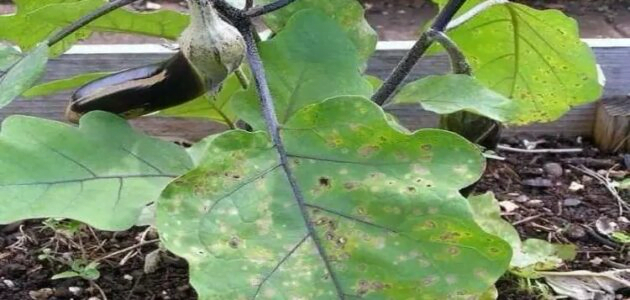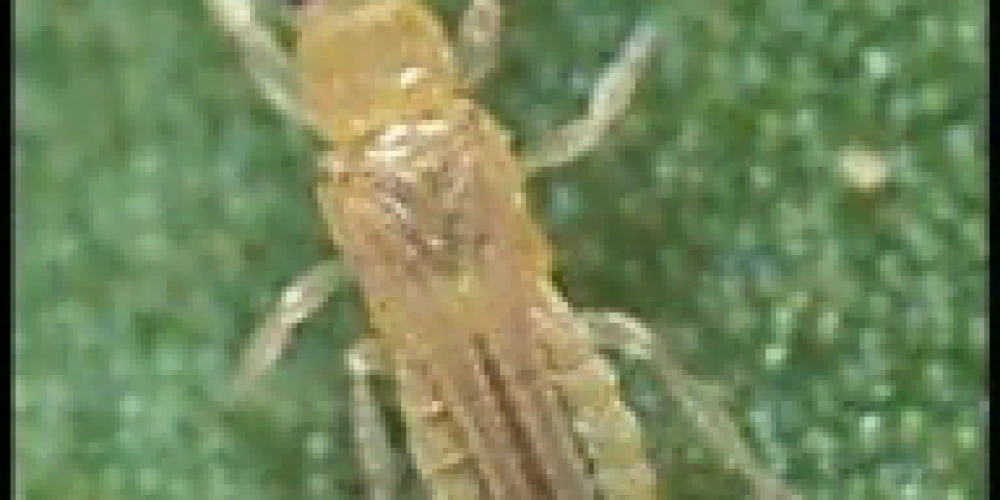Table of contents of the article
Toggle

Eggplant thrips are one of the harmful insects that infect eggplant and affect the quality of the crop. In this article on your website, WORLD OF PLANTS, we review the most important information about this insect and ways to combat it.
Introduction to thrips insect on eggplant
- Symptoms of infection appear from April to August
- Thrips feed on leaves by sucking plant juices, which leads to yellowing and curling of the leaves.
- The infestation is characterized by the presence of wrinkled leaves whose edges curve upward, and the presence of silver spots on the lower surface of the cotyledon leaves, for insects to absorb the juices through the outer epidermis, and the void is filled with air bubbles that reflect light and give this silvery appearance.
- Feeding on flowers causes poor pollination and flower fall.
- Fruits become deformed as a result of repeated feeding, especially in the neck or cup area of the fruit, and small-formed fruits fall.
- The presence of thrips is identified by placing a white sheet of paper and shaking the plant on the leaf. Thrip nymphs fall on the leaf. Pictures showing the damage caused by thrips on fruits:
Form and description of thrips insect on eggplant
Eggplant thrips are small insects like aphids and mealybugs, and they resemble similar thrips such as cotton thrips and others.
Thrips insect on whole eggplant
The adult insect is no more than 2.5 mm long. The general color is yellow-orange, and the surface of the body is divided and elongated like a long, thin needle, resembling the European old needle insect. While the wings, legs, and antennae of this thrips are a less dark, whitish yellow color.
Eggplant thrips nymphs
As for the incomplete nymphs or instars, they are pale or light in color at young ages, then gradually turn to dark yellow with advancing age of the nymph, and the nymphs are smaller than the full thrips.
Eggplant thrips infection
1. Manifestations of eggplant blight infection
The manifestations and symptoms of eggplant thrips infection are manifested in the form of absorption of plant cellular juice into the tissue of eggplant leaves and young branches in particular. Adult and incomplete thrips attack the epidermis of leaves, and then feed by sucking their juice. Leaves and young and young eggplants turn yellow and develop gray lesions in what look like small, lumpy, granular white areas in the form of a colony.
2. Exacerbation of injury and economic damage
The surface of the affected eggplant leaves and fruits is covered with pale whitish dots from thrips secretions and their shedding. This hinders the breathing of the leaves and the commercial value of the resulting total eggplant crop deteriorates, with damage reaching 87%. Also, one of the symptoms of infection is that the affected leaf becomes distorted and its edges become wrinkled and then falls or remains in a distorted state on the plant. The infection is also more severe in areas of dense eggplant cultivation and where farmers do not care about planting distances and the danger of excessive plant density that prevents food and air and spreads diseases and insects.
Danger of eggplant thrips
1. Risk level
The danger of eggplant thrips stems from the fact that this pest weakens the eggplant plant in the areas of infection, including leaves and fruits, which leads to the attraction of other insects to the infected fields, such as the tomato leaf miner Tuta absoluta, the tomato moth, tunnel makers, moths, flies, and others. Some of the pests that can be attracted to the potato weed are Gryllotalpa gryllotalpa, the European corn borer, and the striped wireworm. Other non-insect pests may also be attracted, such as fungi (such as powdery mildew, downy mildew), and viruses such as thyme virus (tomato curling and yellowing).
2. Having to apply integrated pest control
As pests overlap, and the risk increases within infected eggplant fields, the farmer may be forced to apply Integrated Agricultural Pest Management (IPM) to protect the eggplant crop and avoid economic loss, and thus avoid excessive costs if the crop is damaged and eliminated by thrips that reproduce quickly and powerfully.
Life cycle of eggplant thrips pest
Eggplant thrips reproduce mainly asexually, due to the scarcity of males.
Asexual reproduction in eggplant thrips
The female thrips lays approximately 50-100 eggs within parts of the eggplant plant, under the epidermis of infected leaves or within the pods of young shoots and young growth. It can also be placed in the corners of intertwined and crowded branches close to the soil surface in case of increased density and lack of attention to pruning operations. The eggs hatch after about 3-4 weeks or less, depending on the temperatures and humidity available in the eggplant and vegetable fields. Then the nymphs emerge from the eggs and begin their work by sucking the cellular juice of the plant and weakening the leaves, fruits, and general condition of the crop.
Follow up on the development of eggplant pest
The small thrips or nymphs begin to suck the plant juices, especially between the parenchymal tissues of the eggplant leaves, and symptoms of infection appear within a few days, then they continue their development and give rise to full-grown thrips. Adult insects may live for several weeks or two months if appropriate conditions are available. It has also been shown that the development of this thrips requires high humidity of about 80-85% in eggplant fields. Also, the pupae of these thrips die if the humidity drops below the appropriate limit for the insect’s body physiology in the infected fields. They also need a suitable temperature exceeding 28-30 degrees Celsius.
Generations of eggplant thrips
The number of generations varies, depending on the temperature and prevailing environmental conditions, especially humidity in general. This thrips has about 3-4 generations per year in medium-humidity eggplant fields, and 5-6 generations in high-humidity fields.
Factors that encourage eggplant thrips infection
There are factors that encourage eggplant thrips infection, and the five most important factors are:
- Neglecting the appropriate planting distances for growing eggplant within vegetable fields.
- The high plant density in eggplant fields is a result of the farmer’s lack of familiarity with the proper method of cultivation, and the increased plant density.
- Also, humidity higher than 60% in eggplant fields greatly encourages this thrips to infect the crop, especially at humidity levels of 70-80%.
- The farmer does not care about the general condition of the eggplant field, including fertilization, irrigation, weeding, and hoeing.
- The presence of weeds in an eggplant field in an infested manner encourages thrips pupae to reproduce and move between the crops.
Control of eggplant thrips
To combat eggplant thrips, a number of preventive and curative measures are followed.
1. Preventive control
Preventive control is carried out by the farmer avoiding high plant density in the fields of the Solanaceae family, as it encourages the reproduction and transmission of pests, prevents ventilation and breathing of the plants, and increases the chances of infection by thrips and insects. Eggplant must also be planted at appropriate distances, which are 80-90 cm between the lines and 70 cm between the plants. The farmer also completely gets rid of weeds in the eggplant field, and takes care of irrigating the field in a balanced manner. Also, increased humidity in eggplant fields encourages thrips infection. Therefore, the farmer reduces humidity as much as possible by not increasing irrigation beyond its limit. Irrigation must be regular, as it is preferable to use drip irrigation and the method of fertilizing with fertilizers dissolved in the irrigation water. This increases the resistance of plants. Eggplant.
2. Therapeutic control
Therapeutic control is carried out as soon as the danger requires the use of the pesticide in eggplant fields, i.e. symptoms of infection appear that make the numbers of the insect community dangerous, where control is carried out through one of the phospho-organic pesticides. The pesticide Dimethoate can be used by spraying on the leaves and branches of eggplant. The pesticide Malathion also gives good results in infected eggplant fields, especially if other pests interfere with the thrips, such as aphids and scale insects. The pesticide Parathion-methyl or Metacystox can also be used by spraying on the affected parts of branches, leaves and fruits.
Pesticide use cycle
In order to prevent pest resistance to pesticides in eggplant fields, a cycle of pesticide use is used. In the first season of thrips infestation, the pesticide Dimeton-S-Methyl or Dimeton is used. In the following season, the pesticide Parathion methyl is used by spraying on the leaves, fruits and branches of eggplant, and in the third season the pesticide is Malathion, taking into account spraying in the middle of spring in the beginning of May. In addition, the previous ring itself must be changed every 9 years for precise control and so that thrips do not form resistant strains in infected and infected eggplant fields.
Integrated field management programme
1. Basic procedures
Integrated management of eggplant thrips is carried out through a combination of agricultural, mechanical, therapeutic and care measures. The farmer relies on an initial deep plowing of the eggplant soil of about 25-35 cm, followed by a shallow plowing of 10-14 cm to soften and break up the soil and get rid of the pupae and eggs of pests, including thrips. Special cardboard or wooden traps are also used and distributed in the eggplant and vegetable field to catch tunneling moths such as the European corn borer, the tomato leaf miner Tuta absulota, the cotton bollworm Helicoverpa armigera, fruit worms, the tomato moth, and others.
2. Supportive measures
The farm depends on using fermented local fertilizer for a period of no less than 6-8 years, then spreading it and distributing it in the eggplant fields, and fertilizing it with nitrogen in three batches. Also, the farmer uses fungicides to eliminate fungi that love moisture, because the presence of thrips encourages fungal diseases, by using the pesticide Mancozeb funjacide on eggplant leaves and branches. The farmer also takes care, as much as possible, to avoid plant density in the eggplant fields and give enough food space for each individual plant to get its share of ventilation, food, lighting, fertilizer and water.
Thus; We have learned about eggplant thrips and the extent of its danger if the infection worsens within the fields of the nightshade family. The farmer will also have learned about the means of prevention and possible treatment for this thrips and the management program applied in the infected eggplant field, as this thrips causes significant damage to field eggplant cultivation and must be dealt with.

In conclusion, we would like to note that we, at the world of plants website, offer you all the necessary services in the world of plants, we provide all farmers and those interested in plants with three main services::-
- Artificial intelligence consulting service to help you identify diseases that affect plants and how to deal with them.
- Blog about plants, plant diseases and care of various crops ... You are currently browsing one of her articles right now.
- An application that provides agricultural consultations to clients, as well as a service for imaging diseases and knowing their treatment for free – Click to download the Android version from Google Play Store، Click to download the IOS version from the Apple App Store.
Sources:




